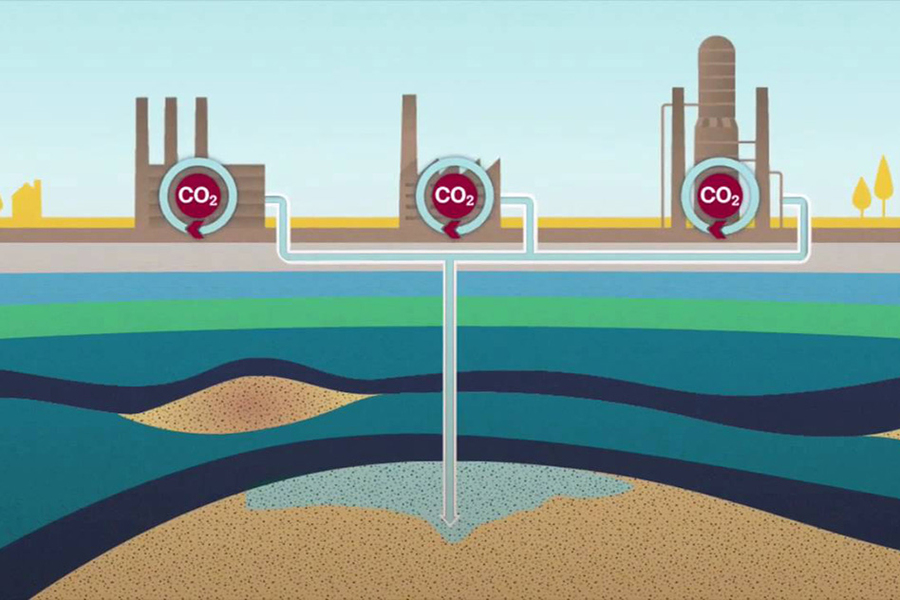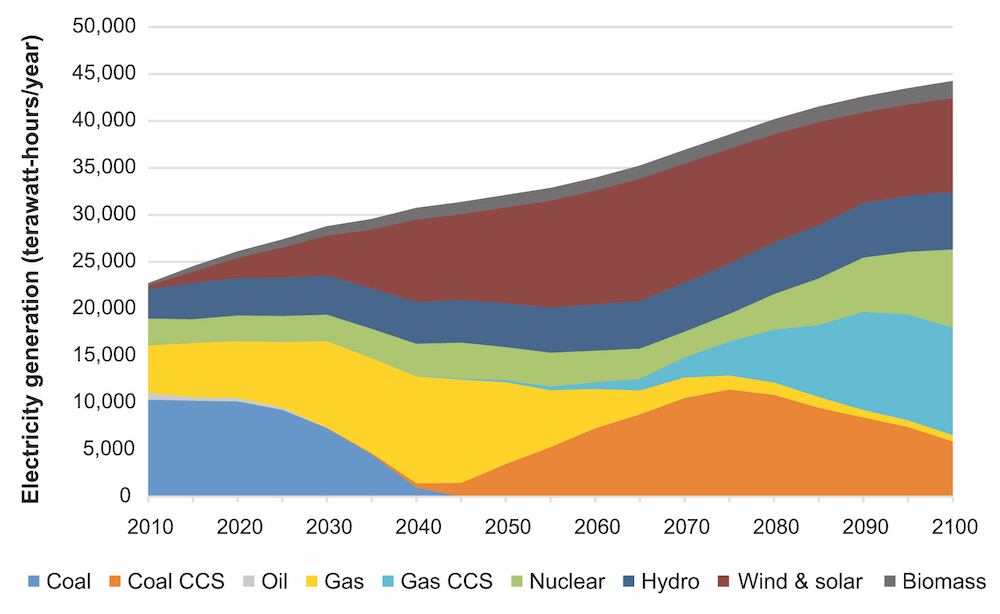
Aiming to avoid the worst effects of climate change, from severe droughts to extreme coastal flooding, the nearly 200 nations that signed the 2015 Paris Agreement set a long-term goal of keeping global warming well below 2 degrees Celsius. Achieving that goal will require dramatic reductions in greenhouse gas emissions, primarily through a global transition to low-carbon energy technologies. In the power sector, these include solar, wind, biomass, nuclear, and carbon capture and storage (CCS). According to more than half of the models cited in the Intergovernmental Panel on Climate Change’s (IPCC) Fifth Assessment Report, CCS will be required to realize the Paris goal, but to what extent will it need to be deployed to ensure that outcome?
A new study in Climate Change Economics, led by the MIT Joint Program on the Science and Policy of Global Change projects the likely role of CCS in the power sector in a portfolio of low-carbon technologies. Using the Joint Program’s multi-region, multi-sector energy-economic modeling framework to quantify the economic and technological competition among low-carbon technologies as well as the impact of technology transfers between countries, the study assessed the potential of CCS and its competitors in mitigating carbon emissions in the power sector under a policy scenario aligned with the 2°C Paris goal.
The researchers found that under this scenario and the model’s baseline estimates of technology costs and performance, CCS will likely be incorporated in nearly 40% of global electricity production by 2100—one-third in coal-fired power plants, and two-thirds in those run on natural gas (see the figure below).

The role of carbon capture and sequestration (CCS) in future electricity generation Under a policy scenario designed to achieve the 2°C Paris Agreement goal, CCS is projected to play a major role in the global electricity mix, particularly in the second half of the century. By 2100, plants with CCS could be responsible for nearly 40% of world electricity production, with a third of that production from coal with CCS and the other two-thirds from gas with CCS.
“Our projections show that CCS can play a major role in the second half of this century in mitigating carbon emissions in the power sector,” says Jennifer Morris SM ’09, PhD, 13, a research scientist in the Joint Program rand the MIT Energy Initiative and the lead author of the study. “But in order for CCS to be well-positioned to provide stable and reliable power during that time frame, research and development will need to be scaled up.”
That would require a considerable expansion of today’s nearly four dozen commercial-scale carbon capture projects around the globe, about half of which are in development.
The study also found that the extent of CCS deployment, especially coal CCS, depends on the assumed fraction of carbon captured in CCS power plants. Under a stringent climate policy with high carbon prices, the penalty on uncaptured emissions can make CCS technologies uneconomical and hinder their expansion. Adding options for higher capture rates or offsetting uncaptured emissions (e.g., by co-firing with biomass, which has already captured carbon through its cultivation and so would produce net negative emissions when combusted) can lead to greater deployment of CCS.
According to the study, CCS deployment will likely vary on a regional basis, with the United States and Europe depending primarily on gas CCS, China on coal CCS, and India embracing both options. Comparing projections of demands for CCS to an assessment of the planet’s capacity to store carbon dioxide (CO2), the authors found that CO2 storage potential is larger than storage demand at both global and regional scales.
Finally, in evaluating the comparative costs of competing low-carbon technologies, the study found that nuclear generation, if public acceptance and economic issues are resolved, could substitute for CCS in providing clean dispatchable power. Wind and solar could also outcompete CCS, depending on how the costs of intermittency (e.g., systems that keep the lights on when the sun doesn’t shine or the wind doesn’t blow) are defined. Progress in resolving technical and economic challenges related to intermittency could reduce the need for accelerated CCS deployment.
Ultimately, the authors determined that the power sector will continue to rely on a mix of technological options, and the conditions that favor a particular mix of technologies differ by region.
“This suggests that policy makers should not pick a winner, but rather create an environment where all technologies compete on an economic basis,” says Sergey Paltsev, deputy director of the Joint Program and a co-author of the study. “CCS has great potential to be a competitive option, and that potential can increase with additional research and development related to capture rates, CO2 transport and storage, and applications of CCS technologies to areas outside of power generation.”
To that end, Joint Program researchers are pursuing an in-depth analysis of the options and costs for the transportation and long-term storage of CO2 emissions captured by CCS technology. They are also assessing the potential of CCS in hard-to-abate economic sectors such cement, iron and steel, and fertilizer production.
Reprinted with permission of the MIT Joint Program on the Science and Policy of Global Change and MIT News. This research was supported by sponsors of the MIT Joint Program and by ExxonMobil through its membership in the MIT Energy Initiative. Further information about the research can be found in:
J. Morris, H. Kheshgi, S. Paltsev, and H. Herzog. “Scenarios for the deployment of carbon capture and storage in the power sector in a portfolio of mitigation options.” Climate Change Economics, November 2020. Online: doi.org/10.1142/S2010007821500019.
This article appears in the Spring 2021 issue of Energy Futures.